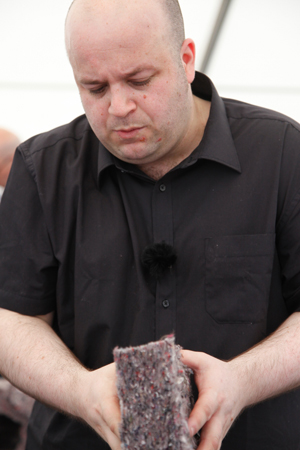
National Manufacturing Institute Scotland moves ahead
Reclaimed textiles are being reinvented as an innovative alternative to insulation by a Scottish firm. Design & Research Studio Kraft Architecture has unveiled its ‘Thermobond' insulation product which blends wool waste fibres to help buildings retain heat. With support from Scottish Enterprise the Glasgow-based company has developed Thermobond as an addition to the multi-billion-pound insulation market and a useful tool in helping Scotland to achieve a low carbon and

28th June 2011
Innovation in Textiles
|
Glasgow

Reclaimed textiles are being reinvented as an innovative alternative to insulation by a Scottish firm. Design & Research Studio Kraft Architecture has unveiled its ‘Thermobond' insulation product which blends wool waste fibres to help buildings retain heat.
With support from Scottish Enterprise the Glasgow-based company has developed Thermobond as an addition to the multi-billion-pound insulation market and a useful tool in helping Scotland to achieve a low carbon and zero waste future.
The company engaged in discussions with Scottish Enterprise, which led to a successful application for a SMART: Scotland grant award to prove the technical feasibility of the product.
In a press statement today, representative body Textiles Scotland said: "Thermobond could help home and business owners to reduce their heating bills by insulating new-build houses and offices and retrofitting lofts."
"Wool is also a naturally fire retardant, so as the Thermobond insulation has a wool content of greater than 60% the product is also fire-proof. For extra security the company also treat the insulation to give it further surface fire resistance. To authenticate its flammability and resistance to smouldering, the product is tested in accordance with British Standard BS5803-4:1985," the statement said.
Bruce Newlands, director of Kraft Architecture, said: "After nine months of research, product development and intensive testing to demonstrate that the product can meet fire, moisture and thermal performance requirements we've trialled a prototype product produced using clean waste wool sourced from Scotland."
"The recycled natural fibres and low energy method of production means that we have developed a product which has excellent thermal qualities that not only keep your house cosy but also allow walls to breathe naturally. This ensures that moisture passes safely to the outside of the building, very much like a woolly jumper," Mr Newlands added.
"We have identified that Scotland has the potential for high growth in the insulation market and we are currently working with a few partners to try and establish a production facility in Scotland while investigating other waste fibre streams for new products," he said.
Cathy Black, head of textiles at Scottish Enterprise, said: "Scotland is home to many technical textile companies which are at the forefront of global development in areas such as clothing, performance wear, SMART materials, medical applications and transport fabrics."
"The use of locally sourced fibres as insulation is an innovative idea and one which could have a significant impact on Scotland's carbon emission reduction targets."
"The transformation of waste textiles into an insulation product could potentially bring real benefits to the economy, the community and the environment while opening up exciting new opportunities for Scotland's textiles industry," Ms Black said.

Business intelligence for the fibre, textiles and apparel industries: technologies, innovations, markets, investments, trade policy, sourcing, strategy...
Find out more